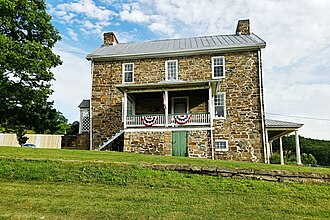Welcome to the Sloan–Parker House, a remarkable relic of American history, nestled in the scenic Mill Creek valley of Hampshire County, West Virginia. This late-18th-century stone residence, also known as the Stone House, stands as a testament to the area’s rich past and the enduring legacy of the families who called it home.
The story of the Sloan–Parker House begins around 1790, when Richard Sloan and his wife Charlotte Van Horn Sloan embarked on a new chapter in their lives. Richard, originally from Ireland, arrived in America after the Revolutionary War and worked as an indentured servant for David Van Horn. Love blossomed between Richard and Charlotte, David’s daughter, and the couple eloped to settle in this picturesque valley. They constructed the original stone section of the house, a sturdy structure with walls as thick as 36 inches at its base, using local fieldstone.
The Sloans were industrious people, running a successful weaving business from their home. Their woven counterpanes, known for their intricate block designs, became famous throughout the South Branch Valley region. Richard and Charlotte raised ten children here, two of whom, John and Thomas Sloan, went on to represent Hampshire County in the Virginia House of Delegates.
In 1854, the Sloan family sold the property to the Parker family, marking the beginning of a new era for the house. The Parkers expanded the house with a wooden frame addition around 1900 and transformed it into a bustling stagecoach stop along the Moorefield and North Branch Turnpike. Travelers on the stagecoach line would find rest and refreshment here, with the family serving meals to weary journeyers.
During the tumultuous years of the American Civil War, the Sloan–Parker House found itself at the center of conflict, visited by both Union and Confederate forces. Union troops ransacked the home for supplies, yet the stone walls stood firm, preserving the house for future generations.
The house’s role as a stagecoach stop ended with the advent of the Hampshire Southern Railroad in 1910, but its historical significance only grew. In 1975, the Sloan–Parker House became the first property in Hampshire County to be listed on the National Register of Historic Places. Visitors today can explore the original stone section, the later wooden addition, and even the nearby Sloan–Ludwick Cemetery, gaining a tangible connection to the past.
The Sloan–Parker House is more than just a building; it’s a portal to the past, offering stories of love, resilience, and community. As you walk through its halls or drive by on the Northwestern Turnpike, imagine the sounds of a bustling weaving workshop, the arrival of stagecoaches, and the echoes of a nation in conflict and peace.




